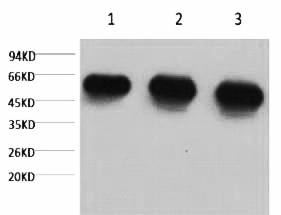
A01080-1.jpg&&Fig.1. Western blot analysis of 1) Hela, 2) rat brian tissue, 3) mouse brain tissue, diluted at 1:5000.|||A01080-2.jpg&&Fig.2. Immunofluorescence analysis of human colon cancer tissue. 1, alpha-tubulin Monoclonal Antibody (3G5) (red) was diluted at 1:200 (4�C, overnight). 2, Cy3 Labeled secondary antibody was diluted at 1:300 (room temperature, 50min). 3, Picture B: DAPI (blue) 10min. Picture A: Target. Picture B: DAPI. Picture C: merge of A+B.|||A01080-3.jpg&&Fig.3. Immunofluorescence analysis of mouse liver tissue. 1, alpha-tubulin Monoclonal Antibody (3G5) (red) was diluted at 1:200 (4�C, overnight). 2, Cy3 Labeled secondary antibody was diluted at 1:300 (room temperature, 50min). 3, Picture B: DAPI (blue) 10min. Picture A: Target. Picture B: DAPI. Picture C: merge of A+B.|||A01080-4.jpg&&Fig.4. Immunohistochemical analysis of paraffin-embedded human uterus cancer tissue. 1, alpha-tubulin Monoclonal Antibody (3G5) was diluted at 1:200 (4�C, overnight). 2, Sodium citrate pH 6.0 was used for antibody retrieval (>98�C, 20min). 3, secondary antibody was diluted at 1:200 (room temperature, 30min). Negative control was used by secondary antibody only.|||A01080-5.jpg&&Fig.5. Immunohistochemical analysis of paraffin-embedded mouse heart tissue. 1, alpha-tubulin Monoclonal Antibody (3G5) was diluted at 1:200 (4�C, overnight). 2, Sodium citrate pH 6.0 was used for antibody retrieval (>98�C, 20min). 3, secondary antibody was diluted at 1:200 (room temperature, 30min). Negative control was used by secondary antibody only.|||A01080-6.jpg&&Fig.6. Immunohistochemical analysis of paraffin-embedded rat kidney tissue. 1, alpha-tubulin Monoclonal Antibody (3G5) was diluted at 1:200 (4�C, overnight). 2, Sodium citrate pH 6.0 was used for antibody retrieval (>98�C, 20min). 3, secondary antibody was diluted at 1:200 (room temperature, 30min). Negative control was used by secondary antibody only.